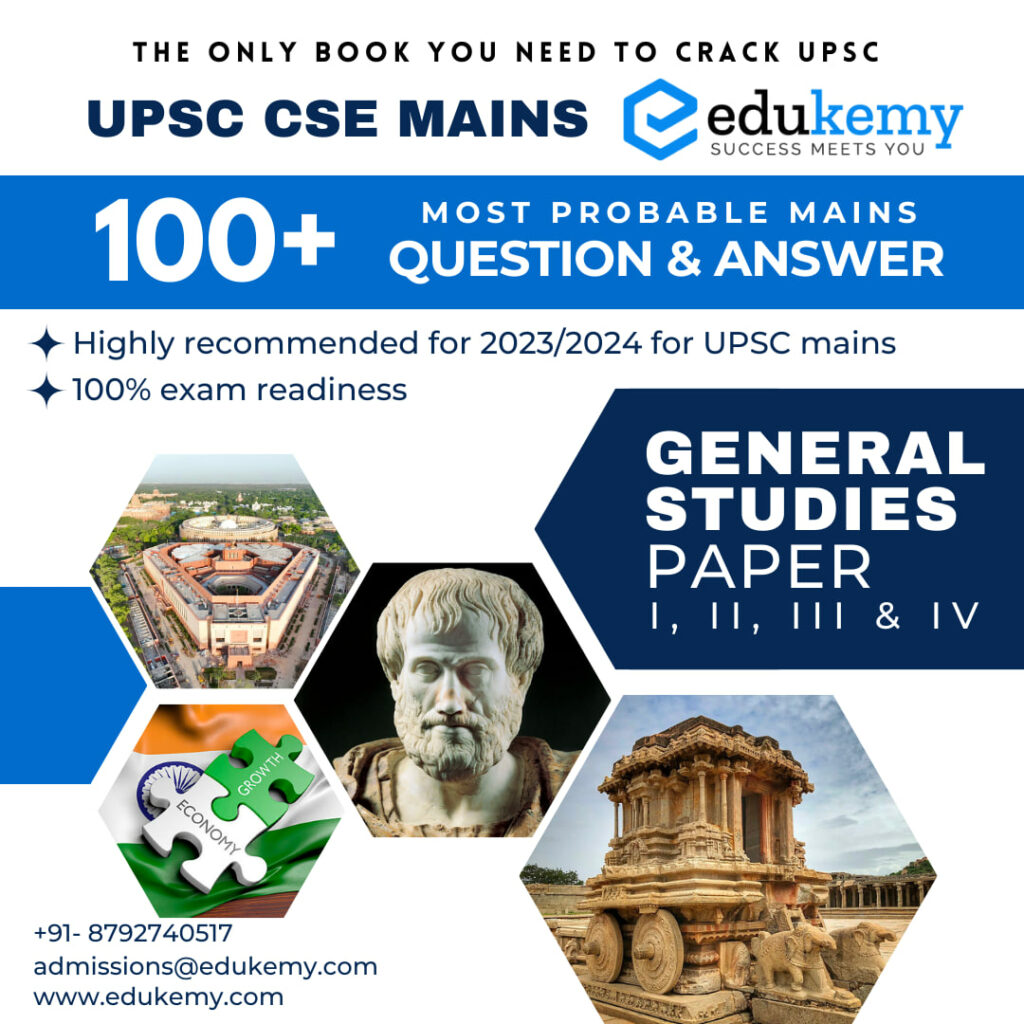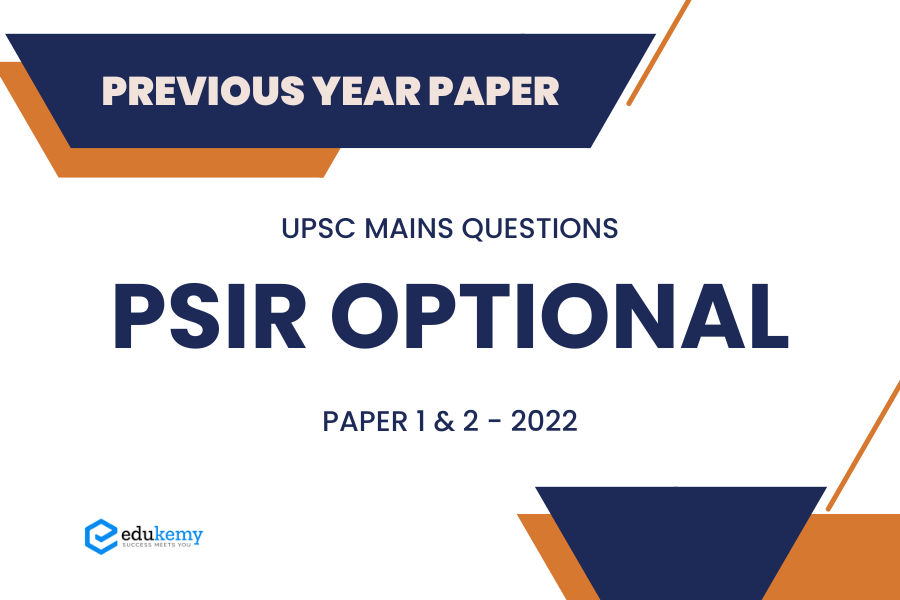

The UPSC (Union Public Service Commission) Main Examination is a highly prestigious and challenging assessment that serves as a gateway to some of the most esteemed civil services in India. Among the various optional subjects available, Political Science and International Relations (PSIR) holds a significant position, attracting candidates with a keen interest in political dynamics and global affairs. The UPSC Mains 2022 PSIR Optional Previous Year Paper is a crucial resource for aspirants preparing for this examination. It offers valuable insights into the examination pattern, question types, and the depth of knowledge expected from candidates. Analyzing these previous year’s papers not only aids in understanding the nuances of the PSIR optional but also helps aspirants fine-tune their preparation strategies, ensuring a comprehensive and effective approach towards achieving success in the UPSC Main Examination.
Contents
- 1 Question Paper Specific Instructions
- 2 Paper-1
- 3 Paper-2
- 4 Frequently Asked Questions (FAQs)
Question Paper Specific Instructions
Please read each of the following instructions carefully before attempting questions
- There are EIGHT questions divided into two Sections and printed both in HINDI and ENGLISH.and questions in ENGLISH.
- The candidate has to attempt FIVE questions in all.
- Question Nos. 1 and 5 are compulsory and out of the remaining, THREE are to be attempted choosing at least ONE question from each Section.
- The number of marks carried by a question/part is indicated against it.
- Answers must be written in the medium authorized in the Admission Certificate which must be stated clearly on the cover of this Question-cum-Answer (QCA) Booklet in the space provided. No marks will be given for answers written in a medium other than the authorized one.
- Word limit in questions, wherever specified, should be adhered.
- Attempts of questions shall be counted in sequential order. Unless struck off, attempt of a question shall be counted even if attempted partly. Any page or portion of the page left blank in the Question-cum-Answer Booklet must be clearly struck off.
Paper-1
SECTION ‘A’
1. Write the following in about 150 words each :
- a). Systems Approach
- b). Cultural Relativism
- c). “Revolution in Permanence”
- d). Bases of Power
- e). Locke’s Social Contract
2. Answer the following:
- a). Factors like community, culture, and nation weaken the hegemony of neo-liberalism today. Discuss.
- b). Equality of estates caused equality of power, and equality of power is liberty.” Comment.
- c). Elitist theory of democracy denies the possibility of democracy as the ‘rule of the people’. Elucidate.
3. Answer the following:
- a). Examine the liberal theory of State in contemporary politics.
- b). Human Rights are complex and contested social practice that organises relations between individuals, society, and the State. Comment.
- c). Individualism is inherent in Hobbes’ absolutist ideology. Comment.
4. Answer the following:
- a). Dr. Ambedkar’s idea of social justice leads to ‘egalitarian justice’ as compared to Rawls’ ‘justice as fairness’ which aims at the notion of ‘pure procedural justice’. Comment.
- b). “The Panchayats with gram Sabhas should be so organised as to identify the resources locally available for the development in agricultural and industrial sectors.” Examine the statement in the context of Gram Swaraj.
- c). Examine the entitlement theory of justice.
SECTION ‘B’
5. Answer the following in about 150 words each :
- a). Analyse the workers’ movement in India in the pre-Independence period.
- b). The Preamble of the Indian Constitution reflects itself as a ‘social contract’. Elucidate.
- c). Legislative Council is a house without any effective powers. Comment.
- d). How far is the National Commission for Backward Classes an empowered body? Assess its role in the context of the rising demand for backwardness among dominant communities.
- e). High concentration of economic activities and consumption patterns in the post-liberalization period has led to the failure of environmental movements in India. Elucidate.
6. Answer the following:
- a). Electoral behaviour of voters is governed more by social and economic factors than political factors. Explain.
- b). The Doctrine of Basic Structure of the Constitution has enhanced the power of judicial review of the Supreme Court. Examine.
- c). Discuss the composition and functions of the Inter-State Council. To what extent has this body been successful in achieving its objectives?
7. Answer the following:
- a). Examine the unique features of the 73rd Constitutional Amendment. Do you think this Amendment would contribute in achieving the goal of empowerment of marginalised sections of society?
- b). The Speaker represents the freedom and dignity of the House. Examine.
- c). Discuss the policy initiatives of the Fourteenth Finance Commission aimed towards promoting and strengthening agricultural development in India.
8. Answer the following:
- a). Ethnicity is the underlying cause which poses a great challenge in the resolution of the problems in the North-East region of India. Comment.
- b). The making of the Indian Constitution is described as an attempt towards a ‘social revolution’. Comment.
- c). How far is it correct that the regional parties have strengthened the Indian democracy and federal system? Substantiate your answer with suitable examples.
Paper-2
SECTION ‘A’
1. Write the following in about 150 words each :
- a). Discuss the main limitations of the comparative method to the study of Political Science.
- b). What are the main challenges faced by the developing countries in the era of globalisation?
- c). Discuss the commonalities between the Marxist and Realist approaches to the study of International Politics.
- d). Bipolar structure of the world is more stable than the multipolar one. Comment.
- e). National Interest is an essentially contested concept. Comment.
2. Answer the following:
- a). How has the electrol democracy augmented the participation of people in the democratic process?
- b). Discuss the role of social movements in strengthening the democratic processes in developing societies.
- c). Describe the composition of the International Court of Justice (ICJ). Discuss its voluntary jurisdiction.
3. Answer the following:
- a). Critically examine the rise of the People’s Republic of China (PRC) as a great power and its implications on Asian Political order.
- b). Discuss the conceptual dimensions of collective security.
- c). Discuss the efficacy of global conventions to combat international terrorism.
4. Answer the following:
- a). Identify and evaluate the reasons for deadlock in the WTO negotiations on fisheries between the developing and developed countries.
- b). What is the realist prescription to the States to ensure their survival in an anarchical world?
- c). The Russian-Ukraine crisis has cast a dark shadow on the energy needs of the member states of the European Union (EU). Comment.
SECTION ‘B’
5. Answer the following in about 150 words each :
- a). Peaceful co-existence remains the cornerstone of India’s foreign policy. Comment.
- b). Discuss the ways and means to realize greater economic cooperation among the Member States of South Asia.
- c). Discuss the steps required to realise ‘hydro-co-operation’ between India and Bangladesh.
- d). Explain the significance fo Basic Exchange and Co-operation Agreement (BECA) for Indo-US strategic relations.
- e). Discuss the role of public diplomacy in the enhancement of India’s global standing.
6. Answer the following:
- a). Discuss the relevance of the demand for a New International Economic Order (NIEO) in the present era of globlisation.
- b). Critically examine the major factors responsible for a turnaround in the trajectory of India’s foreign policy in the post-cold period.
- c). Discuss the reasons behind India’s refusal to sign the nuclear non-proliferation treaty (NPT).
7. Answer the following:
- a). What are the main drivers fo India-Japan Strategic and Global Partnership?
- b). What are the implications of the ‘Look-East’ Policy on the north-eastern region of India?
- c). Explain the factors which justify India’s claim for a permanent seat at the UN security council.
8. Answer the following:
- a). How does India-Israel bilateral ties reflect the autonomy of India’s foreign policy choices?
- b). Discuss the consequences of illegal cross-border migration in India’s northeastern region.
- c). Discuss India’s vision of a New World order in the 21st century.
Frequently Asked Questions (FAQs)
Q: How should I approach the PSIR optional paper in UPSC Mains?
A: It’s essential to thoroughly understand the syllabus, focus on key concepts and theories, and practice answer writing. Analyzing previous year papers and adopting a multidimensional approach to current affairs can enhance your preparation.
Q: What are some common mistakes candidates make in the PSIR optional paper, and how can they be avoided?
A: One common mistake is insufficient depth in answers. To avoid this, candidates should prioritize quality over quantity, providing in-depth analysis and using relevant examples. Additionally, staying updated on contemporary issues and integrating them into answers is crucial.
Q: How can I improve my answer writing skills for the PSIR optional paper?
A: Regular practice is key. Set aside dedicated time for answer writing, focus on structuring your responses logically, and ensure clarity in expression. Seek feedback from mentors or peers and incorporate it into your subsequent practice to continually refine your writing skills.
In case you still have your doubts, contact us on 9811333901.
For UPSC Prelims Resources, Click here
For Daily Updates and Study Material:
Join our Telegram Channel – Edukemy for IAS
- 1. Learn through Videos – here
- 2. Be Exam Ready by Practicing Daily MCQs – here
- 3. Daily Newsletter – Get all your Current Affairs Covered – here
- 4. Mains Answer Writing Practice – here
Visit our YouTube Channel – here

